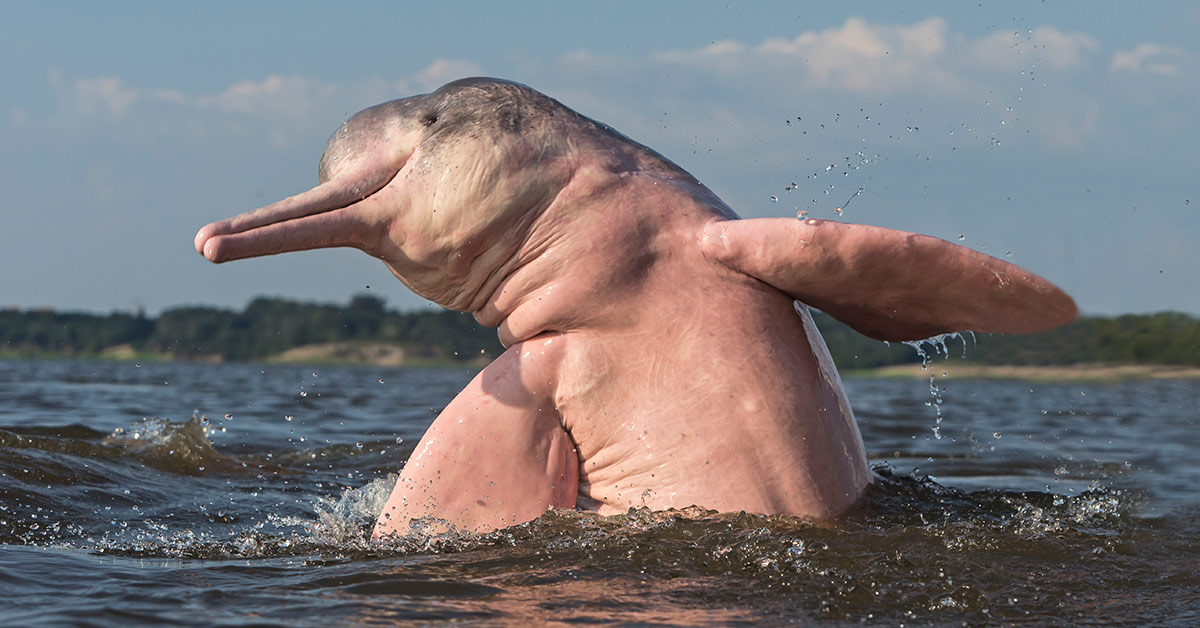The Amazon river dolphin is the largest freshwater dolphin in the world. They grow up to nine feet long and weigh up to 450 pounds. Also, these freshwater dolphins are bright pink. Just imagine sailing down the Amazon river surrounded by miles of rainforest canopies, spotting pink dolphins hunting beneath the surface.
Amazon river dolphins, also called Botos, sport bulbous foreheads and long, skinny beaks. Only the males can pink. Researchers theorize that the brighter the pink, the more attractive the males are to female dolphins during mating season. Additionally, the coloring can be scar tissue from fighting or rough games. [1]
“They are very special creatures,” said Natanael dos Santos, a guide working at the Mamirauá Institute. “They are extremely intelligent and can display a complex set of behaviors, even like humans.”
Pink Dolphins in the Amazon
During mating, males often hold branches, grass, or even turtles in their mouths to impress females. Their gestation period is 11 to 15 months, and the babies stay close to their mothers for about the first year or two of their lives. Therefore, females tend to reproduce only every three to five years.
“They are a very slow reproductive species,” said Dr. Vera da Silva, a researcher for INPA, the Amazon research institute. “If the removal is higher [than the reproduction and rearing rate] the species does not have the capacity to replace itself.”
Botos are able to swim easily between the narrow tributaries of the rivers and tangled branches. This is due to their un-fused neck vertebrae, which lets them bend at a 90-degree angle. Plus, their long snouts help them dig through the mud for crustaceans or for reaching through branches to reach small fish. Botos are also the largest of the freshwater species, with powerful flippers and a hump instead of a dorsal fin. The pink color helps the dolphins better camouflage with the reddish, murky Amazon river during heavy rain. [2]
Traditional Amazonian belief states that these pink dolphins are magical beings; they sometimes walk onshore looking like beautiful humans. Then, they can seduce nearby villages during the night and bring them to the river where they all transform into dolphins. Plus, they always wear hats to hide their blowhole — the way to identify these creatures. Popular belief also states that killing Botos causes bad luck.
Read: Authorities Seize Whale Poop Worth $1 Million in Sting Operation
Protecting an Endangered Species
Unfortunately, they have been classified as “endangered” since 2018 by the International Union for Conservation of Nature. They now have internationally protected status. Although the estimated populations of these pink dolphins are in the tens of thousands, it’s difficult to determine how many there actually are. The murky Amazon river is not conducive to counting dolphins. Therefore, dolphins are protected by Brazilian laws, making it illegal to kill them. However, poachers target these creatures; the mammals’ fatty blubber is used as bait to catch catfish.
“There is a huge amount of ignorance,” said Da Silva. “We need better information on fishing practices. There aren’t strong enough laws to make fishermen report what they catch.”
Other Threats to the Species
Marcelo Oliveira, a conservation specialist at World Wildlife Fund Brazil (WWF), agreed. “Fishing is a threat but we don’t have enough data,” he says. “If we don’t know where the river dolphins are, we can’t say how bad [the threat] is. But it’s expensive to do expeditions to monitor population trends.” [3]
However, fishing and poaching isn’t the only risk to these pink dolphins. “Bycatch sees so many dolphins caught in fishing nets, gold mining in the region has led to mercury poisoning in the water, and the construction of hydroelectric dams has reduced their habitat and genetic pool,” said Oliveira.
Fortunately, conservationists are working to preserve this species. As Lila Sainz, head of global environmental group WWF. “Everything that affects dolphins affects the humans that use those resources, and it inhabits the surrounding marine ecosystems. So, if dolphins are doing well, people are doing well,” she said. [4]
Related: Rare Albino Dolphin Gives Birth to Lovely Pink Calf
Sources
- “Amazon River Dolphin.” National Geographic.
- “Among Other Amazing Creatures, the Amazon Has Pink Dolphins.” How Stuff Works. Laurie L. Dove. November 4, 2021
- “Amazon river dolphin risks extinction if Brazil moratorium not renewed.” Mongabay. Peter Yeung. June 16, 2020
- “Rare pink dolphins saved by high-tech fishermen in the Amazon.” Euro News. Ben Anthony Horton. October 12, 2021

